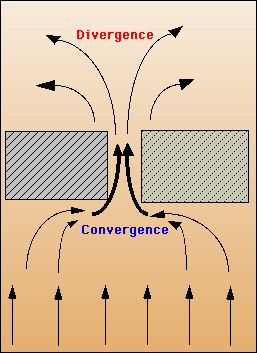Convergence
 We have mentioned that air spirals into low pressure centers due to the earth's spin. But where does the air go then? It cannot go into the ground, and so must compress and move upwards rapidly. The zone where the air meets is known as a convergence zone. Convergence can happen in the horizontal direction as well. Imagine two buildings beside each other as in the figure. Wind blowing against them will converge and go through the space that separates them, moving faster than the original flow because it is compressed. This is also called channeling. The opposite of convergence is divergence -- when air spreads out and slows down because of decompression. Air converges at the surface in low pressure systems and diverges aloft. The opposite takes place in high pressure system. Convergence is one method of vertical air motion.
We have mentioned that air spirals into low pressure centers due to the earth's spin. But where does the air go then? It cannot go into the ground, and so must compress and move upwards rapidly. The zone where the air meets is known as a convergence zone. Convergence can happen in the horizontal direction as well. Imagine two buildings beside each other as in the figure. Wind blowing against them will converge and go through the space that separates them, moving faster than the original flow because it is compressed. This is also called channeling. The opposite of convergence is divergence -- when air spreads out and slows down because of decompression. Air converges at the surface in low pressure systems and diverges aloft. The opposite takes place in high pressure system. Convergence is one method of vertical air motion.
Buoyancy deals primarily with stability, which we will discuss more thoroughly in Session 6. As air warms, it expands, becoming less dense. If the air around it is sufficiently more dense, then the air parcel will become buoyant and rise, or "float" upward. Since density changes as temperature changes, the temperature profile of a layer is very important. If the surface is warm, and it is very cold aloft, then warming air parcels will be able to rise rapidly to great heights, since the temperature of the surrounding air decreases more rapidly than the temperature of the warm air parcel. This the the basic concept of buoyancy. There will be much more detail in Session 6.
The features of the land can also force air to move vertically. Let's use a mountain range as an example. Air moves across land and reaches a mountain range. Because it cannot go through the mountain, it must rise and go over the mountain. As the air rises, it cools. Once it moves over the range, it will sink and warm again. A mountain range is a large scale example, but the same scenario also holds true for smaller terrain features (hills, buildings, dog houses, etc.).
All of these situations play a crucial role in the formation of clouds and precipitation. As air rises it cools, and the vapor it carries cools and condenses to form water droplets. Vertical motion of any kind has an impact on cloud formation.




 We have mentioned that air spirals into low pressure centers due to the earth's spin. But where does the air go then? It cannot go into the ground, and so must compress and move upwards rapidly. The zone where the air meets is known as a convergence zone. Convergence can happen in the horizontal direction as well. Imagine two buildings beside each other as in the figure. Wind blowing against them will converge and go through the space that separates them, moving faster than the original flow because it is compressed. This is also called channeling. The opposite of convergence is divergence -- when air spreads out and slows down because of decompression. Air converges at the surface in low pressure systems and diverges aloft. The opposite takes place in high pressure system. Convergence is one method of vertical air motion.
We have mentioned that air spirals into low pressure centers due to the earth's spin. But where does the air go then? It cannot go into the ground, and so must compress and move upwards rapidly. The zone where the air meets is known as a convergence zone. Convergence can happen in the horizontal direction as well. Imagine two buildings beside each other as in the figure. Wind blowing against them will converge and go through the space that separates them, moving faster than the original flow because it is compressed. This is also called channeling. The opposite of convergence is divergence -- when air spreads out and slows down because of decompression. Air converges at the surface in low pressure systems and diverges aloft. The opposite takes place in high pressure system. Convergence is one method of vertical air motion.
 The Shodor
Education Foundation, Inc.
The Shodor
Education Foundation, Inc.